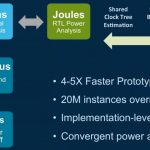Nowadays, verification as one of the most complex SoC, FPGA, and ASIC development flow stages always requires new approaches. The following is an introduction to TcL vs/ with SystemVerilog and VHDL, the first in a 3 part series. Part 2 will be “Tcl vs Python, Bluespec” and part 3 will be “VerTcl description”.… Read More
Tag: soc
A Connectivity Verification Idea
A Wirble
In case you hadn’t noticed, I like to write from time to time about EDA product ideas. I assume these are somewhat original, but given the maxim “there’s nothing new under the sun…”, I may well be wrong. In any event, I like to share these ideas if only to demonstrate that innovation in EDA is not stalled because we’ve run out big,… Read More
Why ARM Enabling Easy Access to Customized SOC’s Matters
The introduction of the Arduino heralded the huge growth and interest in MCU based designs by people who could never before easily put together the hardware and software system required for implementation of their ideas. I remember the first time I saw the Arduino in use. I was at a talk on how a system for controlling propane jet solenoids… Read More
Optimizing Quality-of-Service in a Network-on-Chip Architecture
The Linley Group is well-known for their esteemed Microprocessor Report publication, now in its 28th year. Accompanying their repertoire of industry reports, TLG also sponsors regular conferences, highlighting the latest developments in processor architecture and implementation.
One of the highlights of the conference… Read More
Nine Cost Considerations to Keep IP Relevant –Part2
In the first part of this article I wrote about four types of costs which must be considered when an IP goes through design differentiation, customization, characterization, and selection and evaluation for acquisition. In this part of the article, I will discuss about the other five types of costs which must be considered to enhance… Read More
Nine Cost Considerations to Keep IP Relevant
It’s about 15 years the concept of IP development and its usage took place. In the recent past the semiconductor industry witnessed start of a large number of IP companies across the globe. However, according to Gary Smith’s presentation before the start of 52[SUP]nd[/SUP] DAC, IP business is expected to remain stagnant for next… Read More
Improve SoC Front-end Design Productivity
I have been involved in SoC developments for a long time. During this period I tried to learn what impacts the productivity and subsequently the market opportunity. Over the last year or so at SoCScape I have been involved designing solutions that can improve them. I have decided to post some of my thoughts here in a series of blogs … Read More
Secret Sauce of SmartDV and its CEO’s Vision
SmartDV started as a small setup in Bangalore in 2008 and by now is one of the most respectable VIP (Verification IP) companies in the world. Having a portfolio of 83 VIPs in its kitty and growing, it has a large customer base, including the top semiconductor companies around the world. The company has grown significantly and is raring… Read More
A New Unified Power Solution at All Levels
When situation demands, multiple solutions appear with a slight lag of time. Similar is the story with estimating and optimizing power at SoC level. In the SoC era, power has become a critical criterion long ago, and there are tools available for power analysis and optimization. However, with more mobile and IoT (Internet of Things)… Read More
Foolproof Your IP before it Stumbles in Higher-up Design
SoC designs are increasingly becoming assemblies of a large number of IP blocks. A well integrated assembly can lead to a successful PPA (Power, Performance and Area) optimized design. However, it is equally important that each IP block is optimized, robust, and integrable in the design. The complexity of an IP and its integration… Read More




